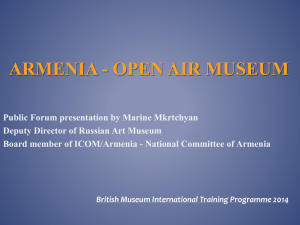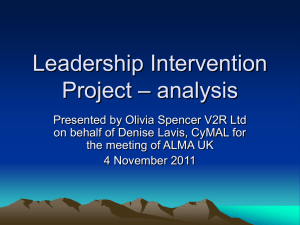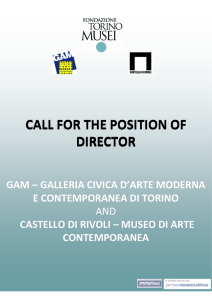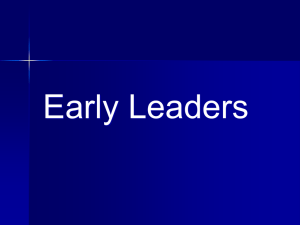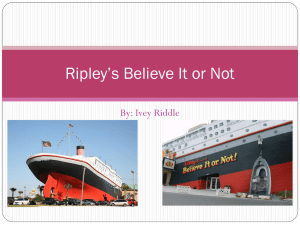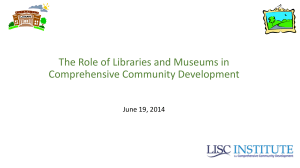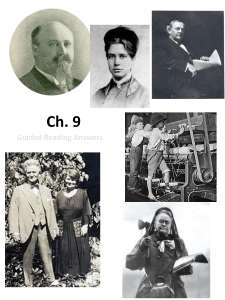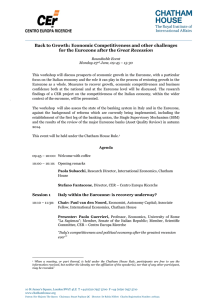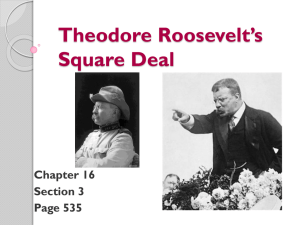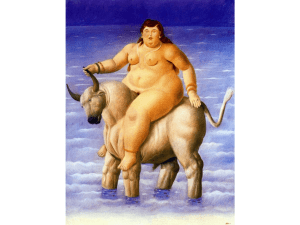Value Difference
advertisement
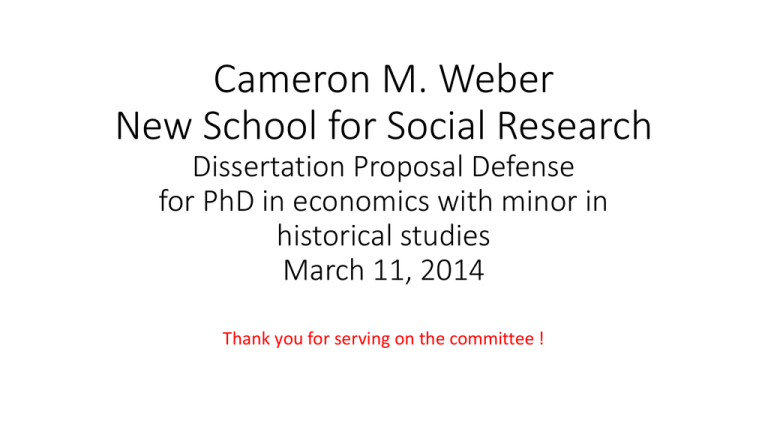
Cameron M. Weber New School for Social Research Dissertation Proposal Defense for PhD in economics with minor in historical studies March 11, 2014 Thank you for serving on the committee ! Three Essays on the Political Economy of Art Outline of Presentation to Committee 1) Overview of three essays and how they hold together as dissertation. 2) Specifics on each essay, a) What is the original contribution to scholarship? b) What is the methodological approach? c) Preliminary findings 1939 World’s Fair, Queens NY Three Essays on the Political Economy of Art I. The Value Difference in Art Economics Art is seen by practitioners of cultural economics as having value beyond exchange and is therefore preanalytically different than other “economic goods”, counter to claim by Mark Blaug that cultural economics does not have a paradigm. II. The Role of Museums in Utility-Enhancing Consumption Fine art as experience or novelty goods, relative to normal goods, contains risk in consumption although can offer higher value in consumption. Museums can help create preferences for fine art at the margin through educational programs, increasing lifetime utility (human flourishing). III. The Political Economy of New Deal Art (1933-1943) as Seen Through the Lens of State Theory Art might be used as propaganda by a self-interested state seeking an increase in discretionary power. Public art which creates preferences in citizens for more state intervention might be seen as “art statism”. I. The Value Difference in Art Economics Contributions: Provides counter-claim to Mark Blaug (2001) that cultural economics lacks a “single dominant paradigm”. Methodology Approach: Reviews canon in art economics and builds categories using Lakatos Methodology of Scientific Research Programs (1978) to test counterclaim. The value difference “hard core” of the research program is irrefutable due to the shared pre-analytic visions of cultural economists. I. The Value Difference in Art Economics Literature review results in this classification Research Program in Art Economics Protective Belt How do economics and culture intersect? Arguments for/against government funding of arts Supply side - economics of creative process and property rights Demand side - preference and price theory Analysis of art markets and institutions Hard Core There is a value difference between art and other economic goods I. The Value Difference in Art Economics One example Category: “How do economics and culture intersect?” Hutter in Klamer, ed., The Value of Culture (1996). Art is “inexhaustible source event” which provides the raw materials for the economy’s “resource event”. The relationship between art (culture) and the economy is symbiotic. Human ingenuity is limitless, but the creative depend on the economy for support. Art and culture are a limitless source of value (not scarcity or market exchange value). Exchange of Value Between Art and the Economy Art (Source Event) Economy (Resource Event) Inexhaustible source of scarce resources Reservoir for support (Constraint) Adapted from Hutter 1996 I. The Value Difference in Art Economics Motivation: The value difference in cultural economics is important because it draws-upon and helps to clarify the role of art and culture in society, value which makes-up and helps to explain our shared historical cultural heritage. Too as claimed the value difference helps to define “cultural economics” as a body of knowledge, and as a research program with its own unique characteristics. II. The Role of Museums in Utility-Enhancing Consumption Contributions: 1. Creates model to illustrate risk hurdle of consuming the novel (the finer things in life such as art which can lead to satisfaction) relative to comfort goods (which can lead to dissatisfaction). 2. Creates measure (unique to literature) for economic performance of Notfor-Profit museums in the United States, which is prioritization of educational programs to address risk hurdle for consumption of novel goods. 3. Addresses tax benefits received by museums due to Not-for-Profit status and compares to educational spending. This may be of interest to cultural economists working with museums at a time of fiscal austerity when tax-exemptions are being reconsidered by policy-makers II. The Role of Museums in Utility-Enhancing Consumption Methodology Approach: i. Theoretical discussion on consumption theory and role of experience goods which can lead to increasing marginal utility (the more someone “consumes” modern art, the more they come to appreciate it) relative to consumption of normal goods. ii. Literature review on the economics of museums and how practitioners measure museum performance. iii. Empirical research into Not-for-Profit museums in the United States including measurements for 1) “top” museums and 2) for prioritization of education, both also unique to literature. II. The Role of Museums in Utility-Enhancing Consumption average taste and utility of consumption role for preferenceformation through education experience goods normal goods 0 time II. The Role of Museums in Utility-Enhancing Consumption Museums are “multiple output firms” (Towse 2010) whose goals “cannot be reduced to one function, it’s three basic functions are research, preservation and communication” (Paulus 2003). Grampp (1989) finds that museums goals are defined by mission statement, board of directors, and “by political representatives if it is a public institution”. My work focuses on Not-for-Profit museums as am interested in the market process, “Fashions and tastes change, unless a museum adapts through time it is unlikely to maintain its visitor attractiveness” (Johnson and Thomas 1978). II. The Role of Museums in Utility-Enhancing Consumption “Top” art museums calculated from Art Newspaper ’s attendance figures (2007) and Paulus (2003) “collectiveness index” concept of a museum’s ability to attract foundation funding as disinterested relative to paid attendance or memberships. (Foundation Center publishes grants data). So “Top” museums are those with largest attendance and/or largest foundation grants in 2007. II. The Role of Museums in Utility-Enhancing Consumption Not-for-Profit organizations are exempt from US income tax, which usually results in exemption from state and local taxes. Estimated real-estate taxes lost due to Not-for-Profit tax code is between $17 and $32 billion, or between 4% and 8% of real estate taxes in the USA (Kenyon and Langley 2011). Some of the best real estate in US cities is owned (tax-free) by universities, religious orders and museums. (A walk around Central Park in NYC will verify this.) A review of the 501(c)3 tax code finds that the “educational” purpose for tax exemption most highly correlates with museum’s “communication” purpose. II. The Role of Museums in Utility-Enhancing Consumption It is not possible to calculate a return on assets for museums because museums are not required to report the value of their collections, this leads to “hoarding” of works. More than half of museum-owned art is in storage (Gampp 1989, 1996). I then determine that a measure to evaluate museum prioritization of education could be percent of current revenues spent on educational activities. II. The Role of Museums in Utility-Enhancing Consumption Of the 27 top museums, only 17 self-report a separate line item in Financial Statements for education activities. In 2007 prior to the financial crisis these 17 museums received $1.3 billion in revenues and spent $68 million on self-reported educational activities. This is an equity creation payout of 5.3%. In 2010 revenues were down 15% yet educational equity creation was up to 5.8%. Equity here being defined as a transfer of utility from those already educated in the arts (e.g., exhibition expenditures) to those not yet educated (e.g., education expenditures). Note that equity transfer payout of around 6% is half-way between the low and high estimates, 4% and 8%, for real estate taxes foregone. III. The Political Economy of New Deal Art (1933-1943) as Seen Through the Lens of State Theory Contributions: Creates using fiscal sociology (Wagner 2007) a model describing precognitive taste creation and socially-formed preferences. Develops concept of “art statism” following Frankel (2006) “print statism” and Cohen (1990) “worker statism”. Discovers primary sources from archives showing negotiations between Roosevelt administration and artists employed by the state. III. The Political Economy of New Deal Art as Seen Through the Lens of State Theory Methodology: Theoretical formulation and precise operational definitions of “propaganda”, “government”, “state”, “tastes”, “preferences” and “self-interest”. Historiography of critiques on relationship between New Deal Roosevelt Administration and the art and public works created by New Deal. Case study approach using artist Ben Shahn archival records with Smithsonian as well as Federal Art Project records from National Archives. III. The Political Economy of New Deal Art as Seen Through the Lens of State Theory Harris Federal Art and National Culture: the Politics of Identity in New Deal America (1995) claims the radio speeches of President Roosevelt (FDR) and the public art created under the New Deal were, “’nationalpopular’ rhetoric supporting Roosevelt’s reformist policies”. In final analysis, Harris finds that the New Deal supported monopoly capital, where the state is seen as subservient to capital. III. The Political Economy of New Deal Art as Seen Through the Lens of State Theory My research takes different tack and assigns agency to a self-interested state whose goal is to maximize its discretionary power (de Jasay 1998). News item on US Solicitor General D.B. Verrilli The “state” is the entity which has the monopoly power to tax, the “government” is the form that represents this state (Wagner 2007). In a democratic form of government the state must maintain its perceived legitimacy (Weber 1919). US federal government revenues doubled as a percentage of the economy between 1933 and 1940 (US OMB President’s Budget 2013). III. The Political Economy of New Deal Art (1933-1943) as Seen Through the Lens of State Theory We are defining propaganda as follows: “Propaganda is the means by which charismatic leadership, circumventing intermediary social and political institutions like parliaments, parties and interest groups, gains direct hold upon the masses.” - Schivelbusch Three New Deals 2006 III. The Political Economy of New Deal Art as Seen Through the Lens of State Theory If we find in archival research of the New Deal art-production that there is intervention into the content of the public art in order to 1) create more discretionary power on behalf of the state and/or 2) to maintain perceived legitimacy we can call this art in service of the state (“art statism”). If both 1) and 2) are absent the art-production is not art-statism. III. The Political Economy of New Deal Art (1933-1943) as Seen Through the Lens of State Theory Archives used, Archives of American Art, Smithsonian Institution, Washington DC US National Archives, College Park, MD Stephen Lee Taller Ben Shahn Archive, Harvard University, Cambridge, MA New York Historical Society III. The Political Economy of New Deal Art (1933-1943) as Seen Through the Lens of State Theory Case from the Ben Shahn papers at the Archives of American Art about the Jersey Homesteads which was to resettle 200 families from the garment district in a back-to-the land “subsistence” and “cooperative” project. Shahn was to live there and to create a mural for the Community Center. Primary sources include the March 10, 1935 Press Release about the project and letters to and from Shahn and New Deal administrators from March 2, 1936 to February 21, 1938. III. The Political Economy of New Deal Art (1933-1943) as Seen Through the Lens of State Theory Political Economy of the New Deal Art Letter to Shahn from Adrian J. Dornbush, Director of Special Skills Office in the Resettlement Administration, dtd. 1/17/1938 III. The Political Economy of New Deal Art as Seen Through the Lens of State Theory III. The Political Economy of New Deal Art as Seen Through the Lens of State Theory Does “Re-elect Roosevelt” push the bounds of a legitimate message for public art in a democracy? Is the International Workers of the World excluded from the labor movement timeline because they are too radical for FDR electoral coalition? Does the AFL-CIO question pertain to the fact that FDR needed both conservative southern white votes and northern city labor votes? Relatedly is CIO leader John L. Lewis to be homogenized because he built up the CIO with unskilled black labor and therefore would be anathema to white southern voters? It is plausible that the answer is yes to at least one of these questions. III. The Political Economy of New Deal Art as Seen Through the Lens of State Theory http://music.columbia.edu/roosevelt/pop_mural.html III. The Political Economy of New Deal Art as Seen Through the Lens of State Theory Three Essays on the Political Economy of Art Thank you.
